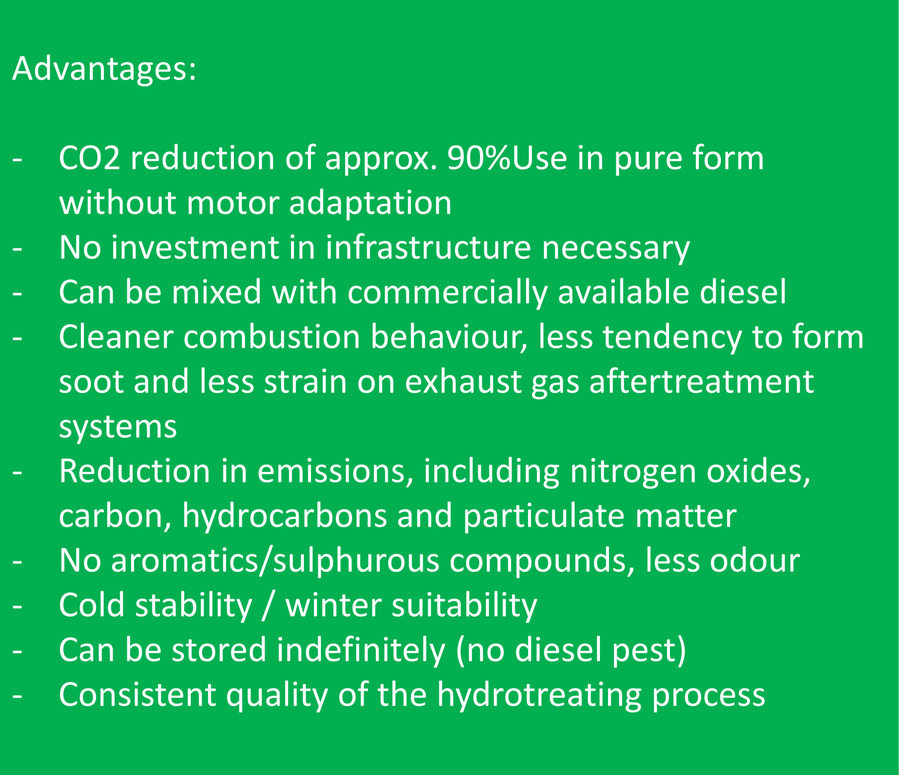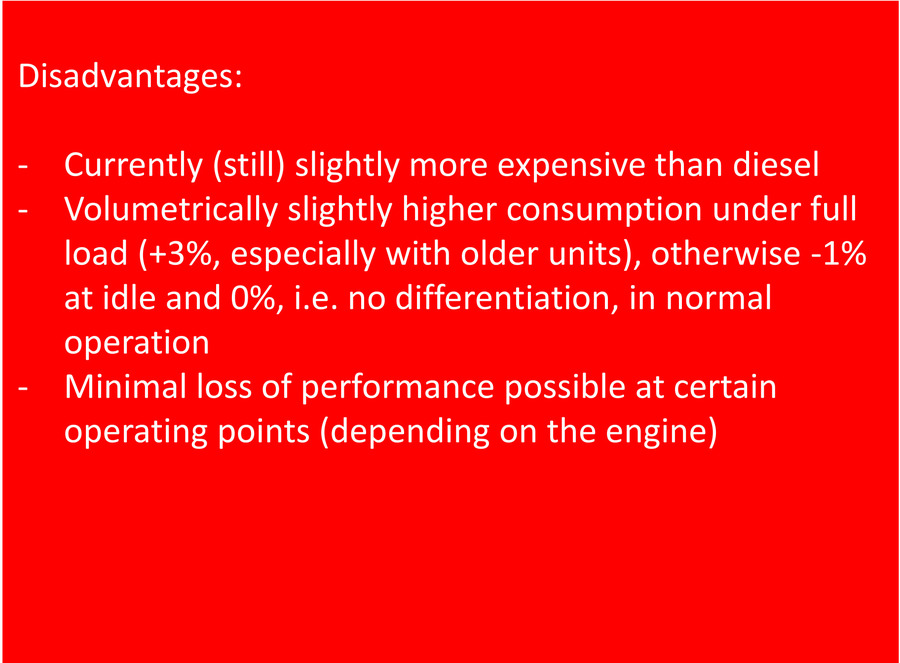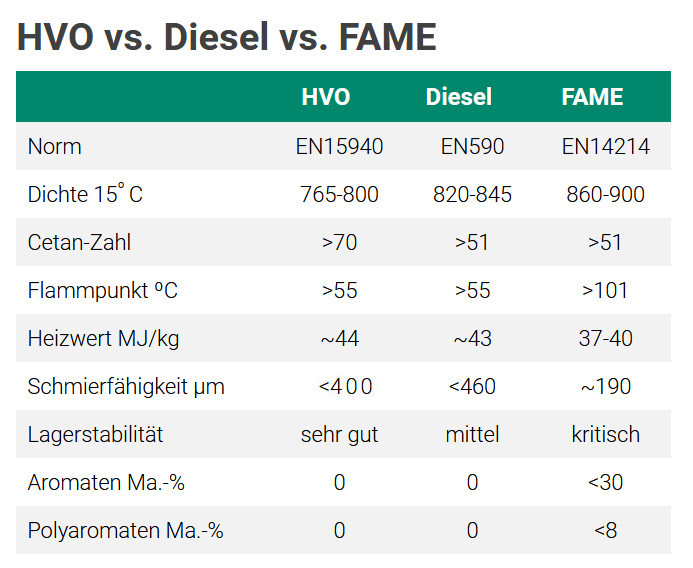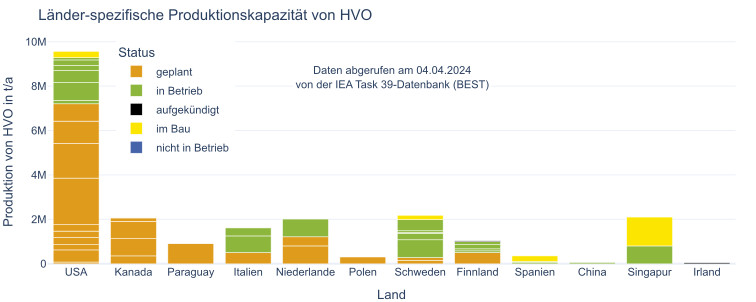Things to know about HVO
sprungmarken_marker_566
What is HVO?
Ingredients: The abbreviation HVO stands for "Hydrotreated Vegetable Oil" and describes the first products converted in this way. Today, the fuel consists of organic waste and residual materials. In most cases, these are organic waste fats from commercial kitchens or animal fats. However, wood residues, cellulose waste, fish waste, liquid manure, sewage sludge, new types of vegetable oils and, in the near future, even plastics are also used as starting materials. The use of palm oil, on the other hand, is undesirable due to environmental risks in plantation cultivation, which is why fuels on this basis have no longer been included in the European greenhouse gas reduction quota (GHG quota) since the beginning of 2023. After purification, the raw materials are mixed with hydrogen in a chemical process and converted into energy-containing fuels. By definition, these are classified as paraffinic fuels.
Physical properties and suitability: HVO is very similar to fossil diesel in terms of its properties. The main differences lie in the following parameters: The density of HVO is around 780 kg/m3(standard values 760 - 800 kg/m3). It is therefore significantly lower than fossil diesel fuels (820 - 845 kg/m3). In addition, the values for the cetane number of HVO (70 to 99) are significantly higher than for conventional diesel (approx. 51 to 60), which leads to faster auto-ignition. Due to the faster auto-ignition, both HC emissions and CO2 emissions are significantly lower in the lower load range and especially in cold weather conditions. Because HVO also contains no oxygen, the fuel can also be stored very well over a longer period of time. HVO also has a lower toxicity.
Greenhouse gas emissions: Depending on the raw material composition of the HVO feedstocks, their use can reduce CO2 emissions by up to 90 percent, as stipulated in the Renewable Energy Directive. The majority of emissions consist of carbon dioxide. The carbon it contains either comes from previously used products (waste materials) or was previously captured from the atmosphere via photosynthesis. In contrast, fossil fuels release oxidized carbon from crude oil, which increases the absolute concentration of CO2 in the earth's atmosphere.
Different mixing ratios possible: HVO fuel can be used in pure form (100 percent) or mixed in any ratio with fossil diesel, for example. This is possible because HVO meets the requirements of DIN EN 15940 for paraffinic diesel fuels, which guarantees the quality of diesel fuels. This in turn means that it is possible to switch between refueling with HVO and fossil fuel without any problems.
Legal status
At the end of March 2024, the Federal Council adopted the revision of what is now the 10th Federal Immission Control Ordinance (10th BImSchV). This ordinance sets out the basic requirements regarding the distribution, sale, labeling and quality of all fuels on the market. As a result of the amendment to the law, German filling stations are now allowed to fill up with 100 percent diesel fuels from renewable sources for the first time. An overview of everything you need to know about the newly approved fuels, in particular HVO100, can be found here.
Who can refuel HVO?
As HVO meets the requirements of DIN EN 15940 for paraffinic diesel fuels, the fuels can in principle be used in any car or commercial vehicle with a modern diesel engine. This is also confirmed by studies conducted by the Karlsruhe Institute of Technology and an endurance test run, the results of which were recently published in connection with the Baden-Württemberg research project "reFuels - Rethinking Fuels". In a test run lasting around three years, the freight forwarder Die Lila Logistik in the Stuttgart/Ludwigsburg area refueled part of its truck fleet with HVO, while another part of the fleet covered the same distance on the same day with conventional diesel. It was investigated whether the paraffinic diesel fuel HVO can be used in the existing trucks without any problems and whether its use actually leads to the desiredCO2 reduction. Both questions were answered with an unqualified yes. For reFuels project manager Olaf Toedter, it is therefore also clear with regard to the use in passenger cars:"With the exception of explicit sports variants, there are no known potential risks when using HVO in existing diesel vehicles." Anyone looking for further information on the compatibility of HVO, especially for their own car, can do so with the help of the DAT compatibility list.
‘With the exception of explicit sports variants, no potential risks are known when using HVO in existing diesel vehicles’
(Dr Olaf Toedter, Institute for Piston Engines, KIT)
How much does HVO cost?
The price of HVO is currently still somewhat higher than for conventional diesel. As a rule, it is five to 20 cents more per litre. The raw materials used are decisive for the pricing: HVO from used cooking oils and waste oils with a CO2 saving of up to 90 per cent is more expensive than, for example, HVO fuel with a less good CO2 balance from palm oil waste. The price is also largely dependent on taxes and levies and the pricing policy of the companies.
After all, no CO2 tax is levied on HVO. The Federal Ministry of Transport BMDV writes on its website: ‘For biogenic fuels and combustibles, the emission factor is set at zero, provided they fulfil the requirements of the Biofuel Sustainability Ordinance. Applying the emission factor of zero means that no certificates have to be purchased for the biogenic fuel component and therefore no increase in costs is incurred by the end consumer.’ This is another reason why the prices for HVO 100 and fossil diesel are likely to converge in the medium term.
Difference to biodiesel/FAME:
HVO is sometimes confused with biodiesel. However, the fuels differ significantly in their production and chemical composition: For biodiesel, vegetable oils or waste materials are converted into fatty acid methyl ester (FAME) in a process called transesterification. However, its chemical quality varies depending on the starting materials used, which is why the maximum permissible concentration of a FAME biodiesel in a mixture with fossil diesel must never be higher than ten percent. In the production of HVO, on the other hand, the purified starting materials (fats and oils) are mixed with hydrogen. This process is known as hydrogenation. Regardless of the starting materials, the product always meets the quality standard of paraffinic diesel, which is why HVO can be used in a concentration of up to 100 percent. In the table opposite you will find a comparison of the most important data and values for HVO, diesel and FAME fuels.
Worldwide HVO refuelling map
eFuelsNow e.V. has created a worldwide map showing all petrol stations for HVO100 and HVO blends.
Symbols on the map:
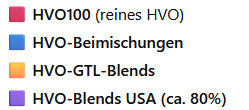
On the map you will also find an overview of the petrol pumps with pictures and a description for mobile use when travelling. The current petrol station figures are also shown there. Show petrol station map
New or discontinued petrol stations?
If you notice any changes, please send us a message:
info ∂does-not-exist.efuelsnow de
Where is HVO produced?
In recent years, oil companies such as Neste from Finland, Eni from Italy and Total from France have established the production of hydrogenated vegetable oil in Europe. In the meantime, all major European oil companies (e.g. Repsol, Preh, Cespa, BP) have established corresponding production facilities and are working on a significant increase in production volumes by 2030. According to data from the International Energy Agency (IEA), international production capacities will continue to increase in the coming years and supplement supply with imports. The charts shown are based on statistics from the International Energy Agency (IEA), which is active in the research, development, market launch and application of energy technologies. As the data is collected by volunteers, updates are often delayed. In this respect, the production volumes stated here are at the lower level, while other studies (e.g. by the French agency Greenea) assume a capacity almost twice as high by 2025.
Helpful tools and links related to HVO
|
ADAC test on the exhaust emissions of HVO100 The test focussed on CO₂ emissions during combustion and compliance with the limits for exhaust emissions that are hazardous to health and therefore limited by law: Nitrogen oxides (NOₓ), carbon monoxide (CO), hydrocarbons (HC) and soot particles. |
|
HVO production volumes are forecast to double by 2028, with demand likely to outstrip supply. Find out where global capacity is located in the Argus Global Capacity Map. |
|
|
|
Worldwide HVO fuelling card and lots of other practical user information. |
|
Details on the production process |
|
ifp Energies nouvelles: Biofuels Dahsboard 2023 Information on biofuels in the transport sector, production capacities and price trends for ethanol, HVO and other renewable fuels. |
|
MEW: Scientific study on the storage and handling of paraffinic fuel in existing tank space The study analyses the compatibility and suitability of the existing infrastructure for HVO 100 and compares the characteristic physico-chemical properties of diesel and paraffinic fuels. |
|
Uniti EnergieMittelstand: Statement The trade association has written a multi-page statement on the current factual and legal situation regarding the technical requirements for the sale of HVO 100 at petrol stations. |



